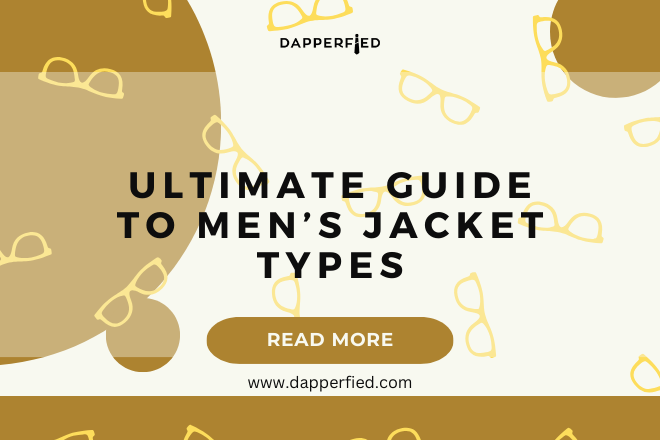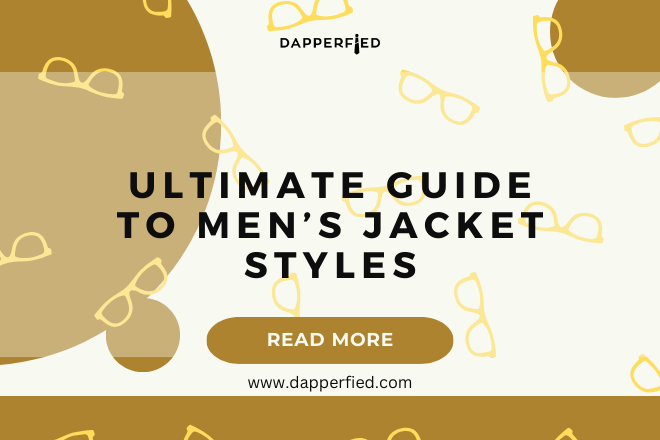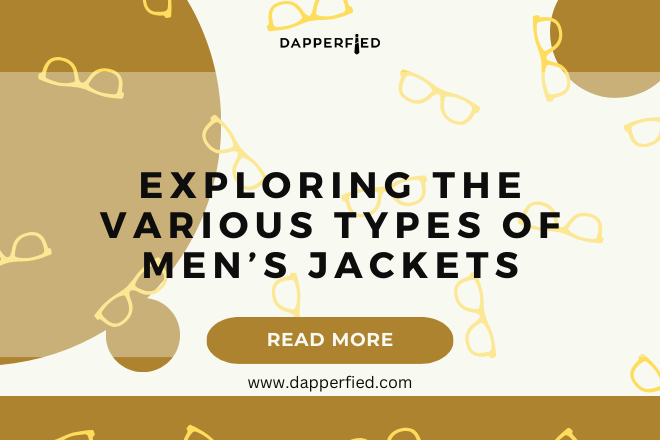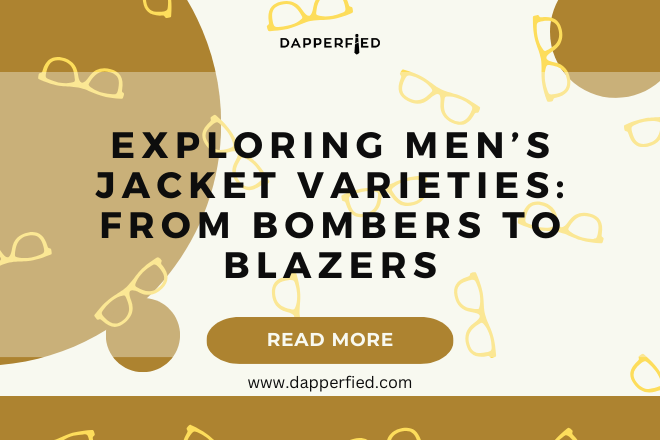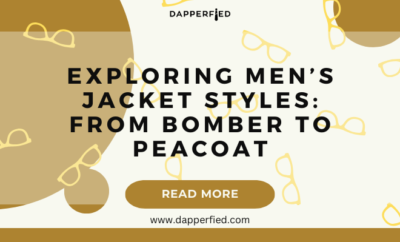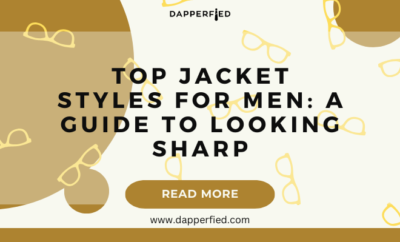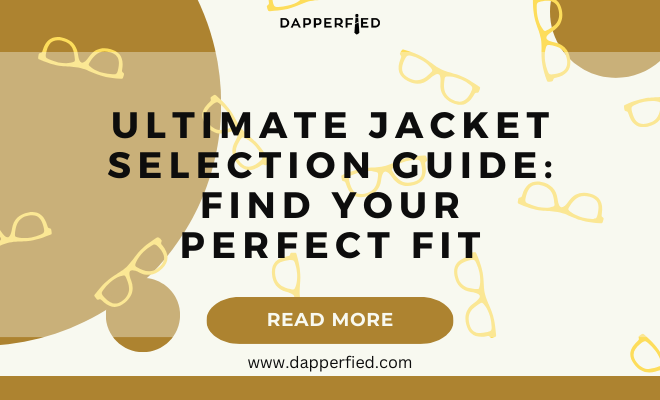
Men's Style
Ultimate Jacket Selection Guide: Find Your Perfect Fit
When it comes to choosing the right jacket, it’s important to first assess your lifestyle and the activities you regularly engage in. Are you an avid outdoor enthusiast who enjoys hiking, skiing, or snowboarding? Or are you more of a city dweller who needs a versatile jacket for everyday wear? Understanding your needs and the demands of your daily activities will help you narrow down the type of jacket that will best suit your lifestyle.
For those who lead an active outdoor lifestyle, a jacket with technical features such as waterproof and breathable materials, adjustable hoods, and plenty of pockets for storage may be essential. On the other hand, if you’re looking for a jacket for everyday wear in the city, you may prioritize style and comfort over technical features. By assessing your lifestyle and activities, you can better determine the type of jacket that will meet your specific needs and provide the functionality you require.
When considering your lifestyle, it’s also important to take into account the climate in which you live. If you reside in a region with harsh winters, a heavy-duty insulated jacket may be necessary to keep you warm and protected from the elements. Conversely, if you live in a milder climate, a lighter weight jacket with less insulation may be more suitable. By understanding your needs and the demands of your lifestyle, you can make a more informed decision when it comes to selecting the right jacket for you.
Key Takeaways
- Assess your lifestyle and activities to determine the type of jacket that best suits your needs
- Explore a variety of jacket styles, from bombers to parkas, to find the one that fits your personal style and practical requirements
- Consider the fabric and insulation of the jacket to ensure it provides the right balance for your climate
- Understand sizing and tailoring options to find the perfect fit for your body shape and preferences
- Evaluate features and functionality such as pockets, zippers, and hood options to ensure the jacket meets your practical needs
- Balance cost and durability when budgeting for a quality jacket that will last
- Make the final decision by choosing the jacket that best meets all of your needs and preferences
Exploring Different Jacket Styles: From Bombers to Parkas
Once you have assessed your lifestyle and activities, it’s time to explore the different jacket styles available on the market. From classic bombers to versatile parkas, there are a wide variety of styles to choose from, each offering its own unique features and benefits. Bomber jackets, for example, are known for their timeless style and versatility. They are often made from durable materials such as leather or nylon and feature a fitted waist and cuffs, making them a popular choice for both casual and semi-formal occasions.
Parkas, on the other hand, are designed for maximum warmth and protection in cold weather conditions. They typically feature a longer length, a hood with fur or faux fur trim, and ample insulation to keep you cozy in freezing temperatures. Parkas are a popular choice for outdoor enthusiasts who need a reliable jacket for winter sports or for those who live in regions with harsh winters.
Other popular jacket styles include puffer jackets, trench coats, and field jackets, each offering their own unique blend of style and functionality. Puffer jackets are known for their lightweight construction and excellent insulation, making them a great choice for outdoor activities in cold weather. Trench coats are a timeless classic that offers a sophisticated and polished look, while field jackets are rugged and durable, making them ideal for outdoor adventures.
By exploring the different jacket styles available, you can narrow down your options and find the style that best suits your personal preferences and lifestyle.
Considering Fabric and Insulation: Finding the Right Balance for Your Climate
When it comes to choosing the right jacket, considering the fabric and insulation is crucial in finding the perfect balance for your climate. The fabric of a jacket plays a significant role in its performance and durability. For those living in wet climates, waterproof materials such as Gore-Tex or eVent are essential to keep you dry during rainy or snowy weather. These materials are also breathable, allowing moisture to escape from the inside of the jacket, preventing you from feeling clammy and uncomfortable.
In colder climates, insulation is key to staying warm and comfortable. There are various types of insulation available, including down and synthetic options. Down insulation is known for its exceptional warmth-to-weight ratio and compressibility, making it an excellent choice for cold weather conditions. However, down insulation loses its insulating properties when wet, so it may not be the best option for wet climates. Synthetic insulation, on the other hand, retains its insulating properties when wet and dries quickly, making it a more versatile option for varying weather conditions.
Finding the right balance of fabric and insulation for your climate is essential in ensuring that your jacket performs optimally and keeps you comfortable in all weather conditions. By considering these factors, you can make an informed decision when selecting a jacket that will meet your specific needs.
Finding the Perfect Fit: Understanding Sizing and Tailoring Options
| Size | Measurements | Fit | Tailoring Options |
|---|---|---|---|
| Small | 34-36 | Tight | Take in the waist |
| Medium | 38-40 | Regular | Shorten sleeves |
| Large | 42-44 | Loose | Let out the waist |
Finding the perfect fit is essential when choosing a jacket that not only looks good but also provides optimal comfort and functionality. Understanding sizing and tailoring options can help you find a jacket that fits well and flatters your body shape. When it comes to sizing, it’s important to refer to the manufacturer’s size chart to determine the best fit for your body measurements. Keep in mind that different brands may have slightly different sizing standards, so it’s important to take accurate measurements and compare them to the size chart provided by the manufacturer.
In addition to standard sizing options, some brands offer tailored or custom fit options for those who want a more personalized fit. Tailored jackets are designed to provide a more precise fit by taking into account individual body measurements such as sleeve length, shoulder width, and torso length. Custom fit options allow you to choose specific details such as the type of collar, pocket placement, and sleeve style to create a jacket that is uniquely tailored to your preferences.
Understanding sizing and tailoring options can help you find a jacket that not only fits well but also complements your body shape and personal style. By taking advantage of tailored or custom fit options, you can ensure that your jacket provides optimal comfort and enhances your overall look.
Evaluating Features and Functionality: Pockets, Zippers, and Hood Options
When evaluating different jacket options, it’s important to consider the features and functionality that will best suit your needs. Pockets are an essential feature to consider, especially for those who need ample storage space for carrying essentials such as keys, phone, wallet, or gloves. Look for jackets with multiple pockets, including interior pockets for added security and organization.
Zippers are another important consideration when evaluating jacket features. High-quality zippers that are durable and easy to use can make a significant difference in the overall functionality of a jacket. Look for jackets with YKK or RiRi zippers, which are known for their reliability and smooth operation.

Hood options are also worth considering, especially for those who need extra protection from the elements. Jackets with adjustable hoods or removable fur trims offer versatility in varying weather conditions, allowing you to customize your level of protection based on your needs.
By evaluating features such as pockets, zippers, and hood options, you can ensure that the jacket you choose provides the functionality you require for your daily activities.
Budgeting for Quality: Balancing Cost and Durability

When it comes to purchasing a new jacket, budgeting for quality is essential in balancing cost and durability. While it may be tempting to opt for a cheaper option, investing in a high-quality jacket can save you money in the long run by providing superior performance and longevity.
Consider the materials used in the construction of the jacket as well as the quality of craftsmanship. High-quality materials such as Gore-Tex or eVent for waterproofing and down insulation for warmth are worth investing in for their durability and performance. Additionally, pay attention to details such as reinforced stitching, quality hardware, and overall construction to ensure that the jacket is built to last.
While budgeting for quality is important, it’s also essential to consider how often you will be wearing the jacket and for what purposes. If you need a jacket for occasional outdoor activities or seasonal wear, investing in a high-end technical jacket may not be necessary. However, if you plan on wearing the jacket regularly or engaging in demanding outdoor activities, investing in a durable and high-performance option is well worth the cost.
By balancing cost and durability, you can make an informed decision when it comes to budgeting for a quality jacket that will meet your specific needs.
Making the Final Decision: Choosing the Right Jacket for You
After carefully considering your lifestyle, exploring different styles, assessing fabric and insulation options, understanding sizing and tailoring choices, evaluating features and functionality, and budgeting for quality, it’s time to make the final decision on choosing the right jacket for you.
Take into account all the factors that are important to you – whether it’s style, functionality, climate suitability, or budget – to narrow down your options. Consider trying on different jackets to see how they fit and feel on your body. Pay attention to how well they accommodate your movement and whether they provide the level of comfort and protection you need.
If possible, seek out reviews from other consumers or outdoor enthusiasts who have experience with the jackets you’re considering. Their insights can provide valuable information about performance, durability, and overall satisfaction with the product.

Ultimately, choosing the right jacket comes down to finding a balance between style and functionality that meets your specific needs. By taking into account all the factors discussed in this guide, you can make an informed decision that will result in finding the perfect jacket for you.
If you’re looking for more than just a jacket, check out this article on the Salvatore Ferragamo Men’s FQ2030013 F-80 Stainless Steel Watch. This guide will help you find the perfect timepiece to complement your outfit and elevate your style. Whether you’re in the market for a casual watch like the Timberland Men’s Bradstreet Plain Toe Oxford or a more sophisticated option like the Raymond Weil Men’s 2847-STC-20001 Maestro Analog Display Swiss Automatic Black Watch, this article has got you covered. https://www.dapperfied.com/salvatore-ferragamo-mens-fq2030013-f-80-stainless-steel-watch/
FAQs
What are the different types of jackets available?
There are various types of jackets available, including bomber jackets, leather jackets, denim jackets, parkas, puffer jackets, trench coats, and windbreakers.
How do I choose the right jacket for my needs?
When choosing a jacket, consider factors such as the intended use (casual, outdoor activities, formal), the climate you will be wearing it in, the material and insulation, and the fit and style that suits your preferences.
What are the key features to look for in a jacket?
Key features to consider when selecting a jacket include waterproof or water-resistant materials, insulation for warmth, breathability, windproofing, adjustable hoods and cuffs, and pockets for storage.
What materials are commonly used in jackets?
Common materials used in jackets include nylon, polyester, Gore-Tex, down, fleece, wool, and leather. Each material offers different benefits in terms of warmth, breathability, and weather resistance.
How do I ensure the right fit for a jacket?
To ensure the right fit for a jacket, consider your body measurements and refer to the brand’s size chart. Pay attention to the jacket’s length, sleeve length, and overall comfort when trying it on.

